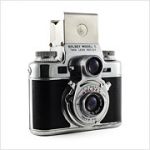Seagull 4A Specifications
| Manufacturer: | Shanghai Seagull Camera Ltd |
| Origin: | China |
| Made in: | Shanghai, China |
| Introduced: | 1968 |
| Type: | Twin Lens Reflex |
| Format: | 120 Film |
| Dimensions: | 10.2 x 14.5 x 10 cm |
| 10.2 x 20.8 x 10 cm (viewfinder open) |
Seagull 4A Overview
The Seagull 4A is a twin lens reflex camera introduced in 1968 by the Shanghai Seagull Camera Ltd and purportedly manufactured to the present day. The Seagull 4A is considered to be a Rolleiflex copy (the premium version of the Rolleicord) and many Chinese photographers in the ’60s and ’70s regarded it as a professional-grade camera although much of that is probably due to its hefty professional-grade price at the time.
Twin lens reflex cameras (TLRs for short) are uniquely equipped with a pair of lenses that do two very different jobs: one is connected to the viewfinder for composing while the other one exposes the film and takes the photograph. The vast majority of TLRs are designed to be used with their built-in waist-level viewfinders but many models also include mechanisms that convert them for eye-level use. For many TLRs like this one, a part of the viewfinder hood simply folds away to reveal a square-shaped hole that you can look through.
The Seagull features an unbranded 75mm f/2.8 finder lens and a 75mm f/3.5 taking lens labeled as the Haiou-31 (“hai ou” being Chinese for “seagull”) with the minimum focus of one meter (3.28 feet). Mated to the taking lens is a five bladed leaf shutter capable of speeds ranging from 1 to 1/300 seconds and bulb.
The shutter speed and aperture controls can be found on either side of the taking lens while the shutter button (with threaded cable release socket) is at 7 o’clock, the self-timer at 6 o’clock, and a standard flash sync socket at 5:30. Focusing is achieved by turning the large knob on the user’s left-hand side. Although the knob has a beautiful integrated focus distance scale, focus is best judged via the ground glass of the viewfinder. For fine tuning, pull the little silver button on the back of the viewfinder assembly downward to engage the handy built-in magnifier. Once the photograph is taken, pull out the film crank from the right-hand side and advance to the next shot as indicated by the small circular frame counter just above it. Once the roll is finished, open up the camera by rotating the knob on the bottom to the simplified Chinese for “open”, reload, and fasten the back by rotating counterclockwise back to the simplified Chinese for “close”.
I bought this Seagull 4A with a jammed shutter for something like $30 on eBay back in 2007, put it on display on my bookshelf, and never got around to getting it fixed. Fortunately, its mechanical woes have no effect on its beauty but I’d still like to eventually get it repaired. Sure, it may not be a fancy Rolleiflex but as the first Chinese camera in my collection, it’s got a special place in my heart.
Find your very own Seagull 4A on eBay.
St Denny, Douglas Cameras of the People’s Republic of China. (Leicester: Jessop Specialist Publishing, 1989), 89.






















